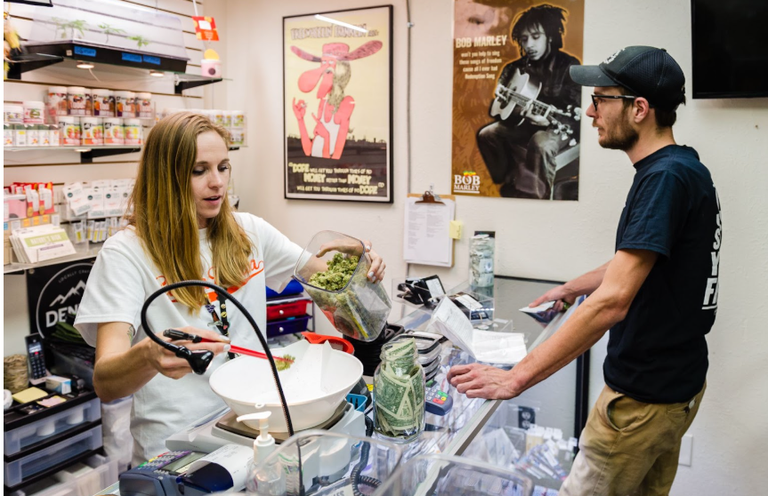New CDOT survey data reveals significant knowledge gaps about driving high
News Release
Media kit is available to download by emailing [email protected].
Statewide — After three years of gathering feedback from budtenders and other cannabis-industry employees, CDOT is using what it’s learned to prioritize its safe-driving message this 420.
An ongoing survey of cannabis industry workers in Colorado, conducted as part of CDOT’s online budtender course with cannabis-industry partner Learn Brands, reveals the important information cannabis consumers want to know — and what will help convince them not to drive under the influence of cannabis. Nearly 1,000 responses were gathered and analyzed.
“Cannabis industry employees — in particular, budtenders and cannabis retail workers — play an important role in changing the public perception around driving high,” said Sam Cole, CDOT Traffic Safety Communications Manager. “CDOT's online budtender course educates budtenders about impaired driving so they can share accurate information with their customers.”
How long to wait after consuming
Many respondents believe their customers were unaware of how long it takes for the impairing effects of cannabis to wear off before it is safe to drive. Course participants expressed their surprise at how long the impairing effects can last, and believed that the general public is largely unaware of this as well.
The Colorado Department of Public Health and Environment (CDPHE) provides the following guidelines:
- The safest choice is to avoid driving after using any form of marijuana product
- Consumption method matters:
- Wait at least six hours after smoking 35 mg of THC
- Wait at least eight hours after eating or drinking up to 18 mg of THC. The typical THC edible in Colorado is portioned at 10 mg THC (e.g., one gummy)
- If you are an infrequent consumer, 10 mg or more of THC is strongly associated with impairment that can affect driving, biking and other safety-sensitive activities
It’s important to note these are only guidelines. Many factors play a role in determining how long the impairing effects of THC take to wear off. When in doubt, don’t take the risk.
Cannabis DUIs are real and they’re a big deal
Responses showed a high level of awareness that you can get a DUI for driving impaired by cannabis. But many were unaware that a cannabis DUI carries the same penalties and financial burden of an alcohol DUI.
Understanding cannabis enforcement and legal limits.
Hundreds of answers asked for details about “legal limits,” how law enforcement determines roadside impairment, and even showed open-container laws in Colorado were either unknown or misunderstood.
- The “legal limit” to determine cannabis impairment is 5ng of active THC per ml of blood. This blood test happens post-arrest as part of the evidence-collection process. Law enforcement tests for active Delta-9 THC.
- Impaired drivers in Colorado can be arrested for Driving Under the Influence (DUI) for substantial impairment or for Driving While Ability Impaired (DWAI) for being impaired to the slightest degree by cannabis, alcohol, or a combination of substances. This is determined by the law enforcement officer during the Standardized Field Sobriety Test (SFST) on the roadside. If cannabis or other drugs are suspected, this can also play a role in the charges. Specially-trained Drug Recognition Experts (DRE) can provide insights about the level of impairment.
- Colorado has an open-container law for alcohol and cannabis. Even if you’re sober, it’s illegal for a passenger to smoke flower, vape or have an open container in the passenger area of a vehicle.
- You can still get a DUI even if you have a medical marijuana card.
Mixing cannabis with alcohol or other drugs
Respondents also expressed surprise — and noted as highly important information — that you are at risk of a DUI even if you’re under the “legal limit” for Blood Alcohol Content and THC. Cannabis combined with alcohol significantly increases impairment. A study by the AAA Traffic Safety Foundation also found that combining substances increases the likelihood of risky driving behaviors like speeding.
420 Safety
Research from CDPHE shows fewer than 20% of cannabis consumers self-reported driving high. This 420, CDOT is recognizing those cannabis consumers in Colorado making smart choices. Peer-to-peer influence is the most effective way to change risky behaviors and help reduce crashes and fatalities on Colorado roads.
CDOT is again hosting a booth at the Mile High 420 Festival in Civic Center Park in Downtown Denver and will be providing booth attendees ride credit, courtesy of AAA Colorado, to encourage people to use rideshare and other alternative forms of transportation.
CDOT is working with The Cannabis Experience, which will offer free shuttle service throughout downtown Denver from 3:30 to 8 p.m., with stops at 14th and Lincoln, Larimer Square and the Colorado Convention Center. The bus will be wrapped in safe-driving messaging.
CDOT's course on Learn Brands is now open to the general public. Take the course to educate yourself and provide feedback of your own.
Learn more about the dangers and consequences of driving high by visiting DriveHighDUI.com. Stay safe this 420 and choose to never drive high.

Crash Not Accident
Note to reporters: Crashes are no accident — they are preventable. We would appreciate you saying 'crash' instead of 'accident' when reporting.
